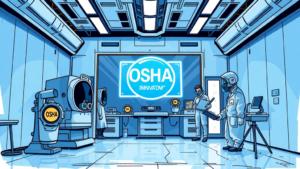
In today’s rapidly evolving business landscape, Environmental, Social, and Governance (ESG) compliance has become a top priority for industries across the board. As companies strive to meet sustainability goals and reduce their environmental impact, the food packaging sector faces unique challenges, particularly when it comes to cleanroom operations. This blog explores sustainable solutions for single-use cleanroom apparel that balance environmental responsibility with operational needs, helping food packaging plants achieve their ESG objectives without compromising safety or efficiency.
The Environmental Impact of Traditional Cleanroom Apparel
Traditional single-use cleanroom apparel has long been a staple in food packaging plants, ensuring product safety and maintaining sterile environments. However, these disposable items come with a significant environmental cost. The majority of conventional cleanroom suits, gloves, and other protective gear are made from non-biodegradable materials such as polyethylene and polypropylene. These synthetic materials can take hundreds of years to decompose, contributing to the growing problem of plastic pollution in landfills and oceans.
Moreover, the sheer volume of waste generated by single-use cleanroom apparel is staggering. A typical food packaging plant may dispose of thousands of suits, gloves, and other protective items daily. This not only creates a substantial waste management challenge but also conflicts directly with ESG goals aimed at reducing environmental impact and promoting sustainability.
The carbon footprint associated with the production, transportation, and disposal of traditional cleanroom apparel further exacerbates its environmental impact. As companies increasingly focus on reducing greenhouse gas emissions and improving their sustainability metrics, the need for eco-friendly alternatives in cleanroom operations has become more pressing than ever.

Key Features of Eco-Friendly Cleanroom Apparel
Fortunately, innovations in biodegradable materials and sustainable manufacturing processes have paved the way for eco-friendly cleanroom apparel that aligns with ESG compliance goals. These sustainable alternatives offer several key features that make them attractive options for food packaging plants:
- Biodegradable Materials: Modern eco-friendly cleanroom suits are often made from compostable SMS (Spunbond-Meltblown-Spunbond) fabric. This innovative material breaks down naturally in composting facilities, significantly reducing long-term environmental impact.
- Recyclability: Some sustainable cleanroom apparel is designed to be recyclable, allowing for the recovery and reuse of materials that would otherwise end up in landfills.
- Reduced Carbon Footprint: The production of eco-friendly cleanroom apparel often involves more sustainable manufacturing processes, resulting in lower greenhouse gas emissions compared to traditional options.
- Certifications: Many sustainable cleanroom apparel options come with certifications that validate their environmental claims, such as compostability or biodegradability certifications. These certifications can be valuable for ESG reporting and compliance.
- Performance: Importantly, eco-friendly cleanroom apparel maintains the high standards of protection and performance required in food packaging environments, ensuring that sustainability does not come at the cost of safety or quality.
By incorporating these features, food packaging plants can make significant strides in reducing their environmental impact while maintaining the necessary standards for cleanroom operations.

How ESG Compliance Officers Can Transition to Sustainable Solutions
For ESG compliance officers in the food packaging industry, transitioning to sustainable cleanroom apparel solutions requires a strategic approach. Here are some actionable steps to integrate eco-friendly options into existing workflows:
- Conduct an Environmental Audit: Start by assessing the current environmental impact of your cleanroom apparel usage. Quantify waste generation, disposal costs, and carbon footprint associated with traditional options.
- Research Sustainable Alternatives: Explore the market for eco-friendly cleanroom apparel that meets your specific needs. Look for options that offer biodegradability, recyclability, and appropriate certifications.
- Pilot Testing: Implement a small-scale pilot program to test sustainable cleanroom apparel in your facility. This allows you to evaluate performance, user acceptance, and compatibility with existing processes.
- Staff Training: Educate your team about the importance of sustainable practices and how to properly use and dispose of eco-friendly cleanroom apparel.
- Supplier Engagement: Work closely with suppliers of sustainable cleanroom apparel to ensure a smooth transition and ongoing support. Consider partnering with companies that share your commitment to sustainability.
- Metrics and Reporting: Establish clear metrics to track the impact of switching to eco-friendly options. This data will be valuable for ESG reporting and demonstrating progress towards sustainability goals.
- Continuous Improvement: Regularly review and update your sustainable cleanroom apparel strategy to incorporate new innovations and best practices in the field.
By following these steps, ESG compliance officers can effectively lead the transition to more sustainable cleanroom operations, contributing significantly to their organization’s overall ESG performance.

Cost vs. Sustainability: Finding the Right Balance
One of the primary concerns when considering a switch to eco-friendly cleanroom apparel is the potential impact on costs. While it’s true that sustainable options may have a higher upfront cost compared to traditional disposable gear, it’s essential to consider the long-term financial and ESG benefits:
- Waste Reduction Savings: By using biodegradable or recyclable cleanroom apparel, companies can significantly reduce waste disposal costs over time.
- ESG Performance Improvement: The adoption of sustainable cleanroom solutions can boost a company’s ESG ratings, potentially attracting environmentally conscious investors and customers.
- Regulatory Compliance: As environmental regulations become stricter, investing in sustainable solutions now can help avoid potential fines or penalties in the future.
- Brand Value: Demonstrating a commitment to sustainability can enhance brand reputation, potentially leading to increased market share and customer loyalty.
- Operational Efficiency: Some eco-friendly cleanroom apparel options may offer improved durability or performance, reducing the frequency of changes and potentially lowering overall usage.
While the initial investment in sustainable cleanroom apparel may be higher, the long-term benefits often outweigh the costs, especially when considering the broader impact on ESG compliance and corporate sustainability goals.
Case Study: Pharmaceutical Company Reduces Carbon Footprint with Biodegradable Cleanroom Apparel
A leading pharmaceutical company recently made headlines by successfully reducing its carbon footprint by 30% through the adoption of biodegradable cleanroom apparel. The company, which operates multiple production facilities, was facing increasing pressure to improve its ESG performance while maintaining strict cleanroom standards.
By partnering with a supplier of compostable SMS fabric cleanroom suits, the pharmaceutical company was able to replace its traditional disposable apparel with a more sustainable alternative. The new biodegradable suits met all necessary safety and performance standards while significantly reducing the company’s waste output and environmental impact.
Key outcomes of the transition included:
- A 30% reduction in overall carbon footprint related to cleanroom operations
- 50% decrease in waste disposal costs
- Improved ESG ratings, leading to increased interest from environmentally conscious investors
- Enhanced employee satisfaction and engagement in sustainability initiatives
This case study demonstrates that it is possible to balance rigorous cleanroom requirements with sustainability goals, resulting in both environmental and business benefits.
ਅਕਸਰ ਪੁੱਛੇ ਜਾਂਦੇ ਸਵਾਲ
What materials are used in eco-friendly cleanroom apparel?
Eco-friendly cleanroom apparel often utilizes materials such as compostable SMS fabric, biodegradable polymers, and recycled or sustainably sourced fibers. These materials are designed to break down naturally or be recycled, reducing long-term environmental impact.
How does sustainable cleanroom apparel meet safety standards?
Sustainable cleanroom apparel undergoes rigorous testing to ensure it meets the same safety and performance standards as traditional options. Manufacturers work closely with regulatory bodies to certify that their eco-friendly products provide the necessary protection and cleanliness levels required in cleanroom environments.
Are there certifications for ESG-compliant cleanroom gear?
Yes, several certifications validate the environmental claims of cleanroom apparel. These may include compostability certifications, biodegradability standards, and eco-friendly manufacturing process certifications. Look for recognized certifications when selecting ESG-compliant cleanroom gear.
Can eco-friendly options match the performance of traditional apparel?
Modern eco-friendly cleanroom apparel is designed to match or exceed the performance of traditional options. Advances in material science and manufacturing techniques have resulted in sustainable products that offer comparable protection, comfort, and durability to conventional cleanroom gear.
What industries benefit most from sustainable cleanroom solutions?
While sustainable cleanroom solutions can benefit any industry requiring sterile environments, they are particularly valuable in sectors with high cleanroom apparel usage and strict ESG requirements. This includes the food packaging industry, pharmaceuticals, biotechnology, electronics manufacturing, and medical device production.
As the food packaging industry continues to evolve, embracing sustainable cleanroom apparel solutions is becoming increasingly crucial for ESG compliance and environmental responsibility. By transitioning to eco-friendly options, companies can significantly reduce their environmental impact while maintaining the high standards required for cleanroom operations.
To learn more about how your food packaging plant can benefit from sustainable cleanroom apparel and improve its ESG performance, visit our sustainability initiatives page. For a detailed analysis of your current environmental impact and potential improvements, we invite you to Access our Carbon Footprint Calculator and take the first step towards a more sustainable future.








